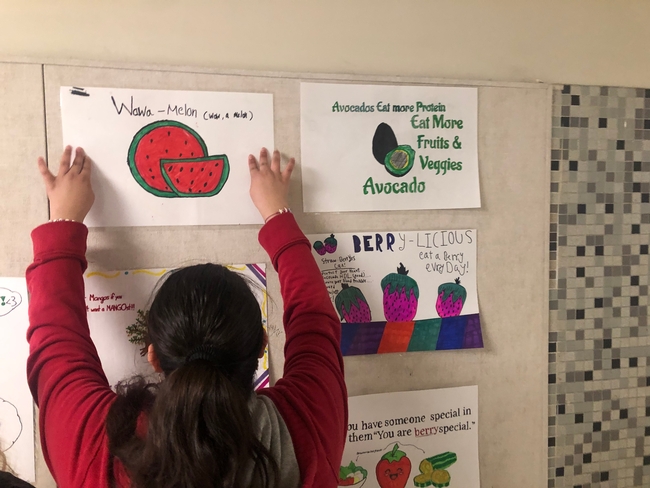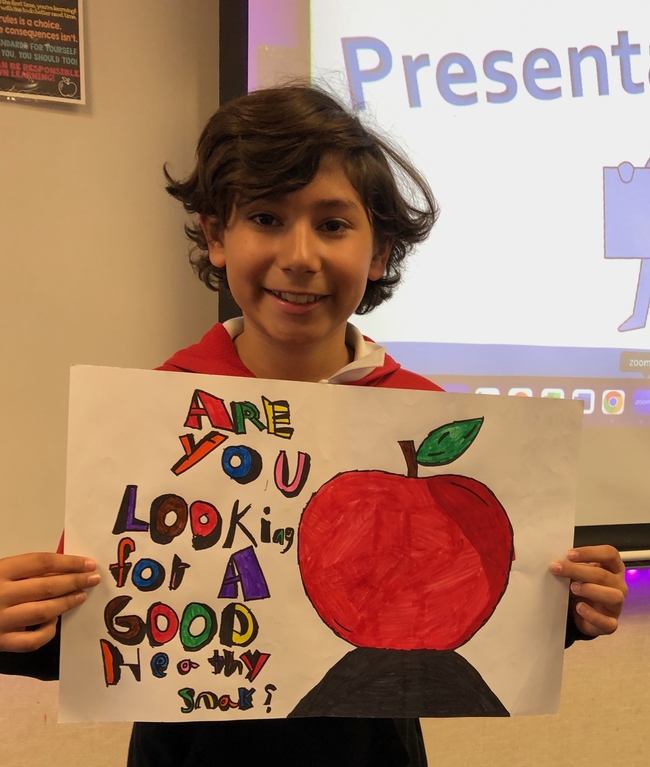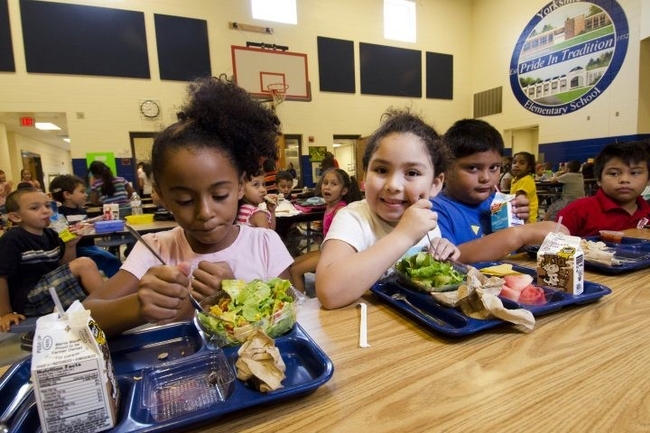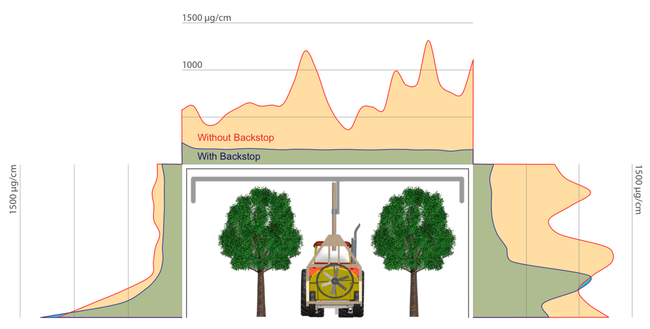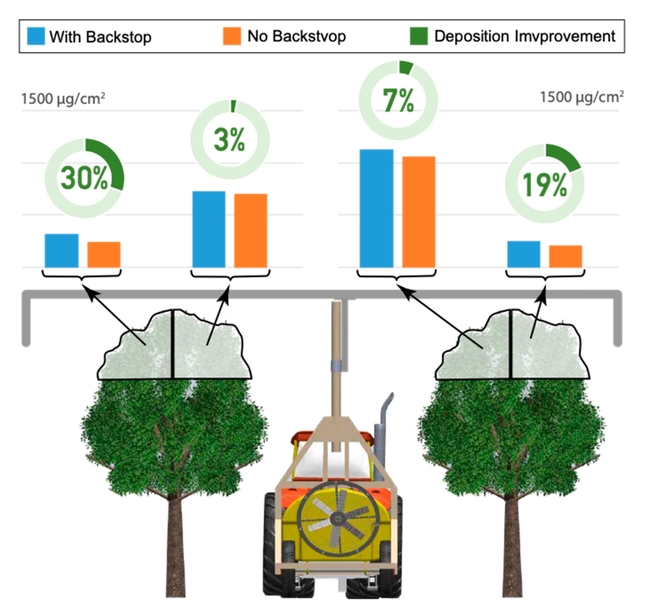- (Strategic Initiative) Healthy Families and Communities
- Author: Reka Vasicsek
- Author: Carolyn Rider
Local Health Departments are improving their CFHL programs using the Nutrition Policy Institute's LEAP awards. Three hundred thirty-three schools and programs were recognized across California for making strides on health and wellness practices.
The Issue
Establishing healthy eating and physical activity practices during childhood has become a priority in education and policy. Promoting nutrition and physical activity best practices in school and childcare programs is key to ensuring the next generation of Californians grows into healthy, active adults.
How UC Delivers
The University of California's Nutrition Policy Institute (NPI), in collaboration with the California Department of Public Health's CalFresh Healthy Living (CFHL) program, coordinates evaluation in schools, early care and education centers, and out-of-school time programs to assess nutrition and physical activity policies and practices. NPI's Site-Level Assessment Questionnaires (SLAQs) are used to assess programs and support plans for program development and improvement. CFHL programs target schools and childcare programs in low-income communities to create health-promoting environments for children.
“Thank you for sharing this! I am meeting with my team next week to discuss our school approach for FY24 and this will be super helpful to help identify new/expanded areas for working with the schools.”
- Local Health Department CFHL Project Director
NPI launched the Leaders in Eating and Activity Practices (LEAP) program in 2023, recognizing 131 schools, 124 early care and education programs, and 78 out-of-school time programs across California for achieving best practices in healthy eating and active living. All 333 sites received recognition in one or more specific areas: nutrition, physical activity, gardens, or breastfeeding support. Additionally, 38 sites were awarded gold, silver, or bronze for comprehensive achievement of overall nutrition and physical activity practices.To receive a LEAP award, sites reported wellness practices on a SLAQ and partnered with their Local Health Department's CFHL program to plan and implement health promotion projects. These projects target a range of children's nutrition and physical activity behaviors by changing policies, systems, and the environment at schools and childcare programs. NPI provided LEAP winners with personalized certificates and a digital promotions package to help them promote their achievement through social media, newsletters, or other media.
“Oh how exciting! Especially since we may be working more closely with middle schools in FY24-26 and this recognition might just encourage them join on for more PSE [policy, systems, and environmental change] focused work.”
- Local Health Department CFHL Project Director
The Impact
LEAP recognition of successful wellness programs can invigorate partnerships and inspire more impactful work. LEAP aims to motivate schools and childcare programs to implement comprehensive, evidence-based strategies to improve child health outcomes. The program also encourages Local Health Departments and their partners to promote their wellness efforts among families and community members, building community awareness of and support for CFHL. Within six months of launching the program, two-thirds of surveyed Local Health Departments reported utilizing the LEAP digital promotions package to promote their partners' healthy eating and physical activity interventions and 22% reported utilizing the LEAP award criteria to inform intervention planning at their partner sites. LEAP awardees and LHD partners have been featured on social media and in community newsletters, newspaper articles, and press releases, enhancing public awareness of CalFresh Healthy Living and UC's Nutrition Policy Institute.
Testimonials from Local Health Department CFHL Project Directors:
“I'm thrilled for our schools and extra excited for the Gold Award!! I can't wait to celebrate ourschools and the fabulous work they are doing. THANK YOU so much for this.”

This family childcare home gained LEAP recognition with a Gold Award and all four badges (Nutrition, Physical Activity, Gardens, and Breastfeeding Support).
“I never thought I would be serving asparagus to the kids. I had a hard time getting them to even eat fruits! After doing all the garden activities, they became more excited and more adventurous to try new foods. They were also very excited to check on their plants every day. They tell me they can't wait to eat the stuff they are growing.”
-Dulce Gaytan, Childcare Provider
- Author: Alexa Erickson
- Contact: Tuline N Baykal
- Contributor: Max Fairbee
CalFresh Healthy Living, UCCE and Master Gardeners in Alameda County promote healthy people and communities: Working with South County Homeless Project residents to grow fresh vegetables in a therapeutic green space.
The Issue
California has one of the highest populations of unhoused people in the nation - 44 out of every 10,000 people do not have stable housing. Being unhoused is strongly tied to food insecurity, including a lack of access to fresh foods and preferred fruits and vegetables. South County Homeless Project is a 24-bed residence for individuals experiencing homelessness. Residents stay from three months to a year and receive support in finding employment and permanent housing. The residence is equipped with a therapeutic garden space, but at the beginning of 2023, it had been overgrown after years of disuse.

How UC Delivers
When Alameda County CalFresh Healthy Living, UCCE decided to restart their adult garden nutrition programming, the neglected garden space at South County Homeless Project presented itself as a great place to start. A nutrition educator who had provided nutrition classes at the site for nearly six years led the collaboration to renovate the large garden onsite. Invaluable support for the garden came from Alameda County Master Gardener's (ACMG) Community Garden Team, who designed the garden and enlisted volunteers to evaluate and amend the existing soil. CFHL, UCCE supplied soil while ACMG provided seedlings. Master Gardeners also lent their expertise to the residents with the workshop, “Gardening Basics”. The nutrition educator, residents, and ACMG volunteers worked together to plant the garden. The team planted 19 varieties of vegetables, fruits, and herbs. As the garden grew, nutrition classes continued with the curriculum, “Fresh from the Garden.” Food from the garden was harvested regularly and enjoyed fresh by residents and incorporated by the chef into house meals.
"One of the chef's used the zucchini in the pasta sauce, it was so good! I didn't really know you could use it that way!" -Resident


The Impact
Residents and staff completed a brief written questionnaire. Ten residents participated in the “Fresh from the Garden” classes at the time of the garden renovations. New residents take part in ongoing garden education, and many residents and staff have increased their use of the space. Those who participated in gardening reported benefits such as learning new ways of preparing and eating local, seasonal vegetables and increased acceptance or awareness of different produce. The food grown in the garden was among the most popular benefits of the garden; the staff chef said that they were able to incorporate many vegetables from the garden into house meals. Residents and staff also stated that being in the garden helped reduce stress and that it was nice to spend time in a peaceful space.
"(The garden) relaxes me from stress. I love the garden." -Resident gardener
The transformation of the yard into a peaceful green space will continue to benefit current and future residents. Those who choose to garden can experience the physical and mental benefits of gardening, such as increased strength and social connection. For residents not interested in or unable to participate in gardening, simply spending time in a green space can have many positive effects on well-being. And by involving residents in planning what vegetables and fruits are planted, they can regain agency over food choice that is often lacking when experiencing homelessness. Overall, the garden renovation and classes connect to the UC ANR public value of promoting healthy people and communities and the condition change "improved community health and wellness" as well as "improved access to positive built and natural environments".

Currently, in April 2024, the garden beds are being prepped and planted with a new group of residents. Seedlings will be planted in April and May. Looking forward, the goals for the garden include adding irrigation to make maintenance much easier. Garden organizers hope to host a Master Food Preservers workshop to help residents learn to process and store produce. Given the success of South County Homeless Project's garden, the CFHL team hopes to bring gardens to similar sites throughout the county as part of the program's adult and senior garden initiative. Another longer-term goal of the initiative is to develop a certificate or training program where residents can receive credits for working in the garden.
"I love the garden and when the cook cooks the vegetables, they taste amazing. I am thankful for this garden and for having the CalFresh Healthy Living team...thank you." -Resident gardener
References
- Thompson R. (2018). Gardening for health: a regular dose of gardening. Clinical medicine (London, England), 18(3), 201–205. https://www.ncbi.nlm.nih.gov/pmc/articles/PMC6334070/
- Easton, Corinna, et al. "The experience of food insecurity during and following homelessness in high-income countries: A systematic review and meta-aggregation." Health & Social Care in the Community 30.6 (2022): e3384-e3405. https://onlinelibrary.wiley.com/doi/10.1111/hsc.13939
- The 2022 Annual Homelessness Assessment Report (AHAR) to Congress. Department of Housing and Urban Development Data. https://www.huduser.gov/portal/sites/default/files/pdf/2022-AHAR-Part-1.pdf
- Author: Eli Israel Figueroa
- Editor: Andra Nicoli
CalFresh Healthy Living (CFHL), University of California Cooperative Extension (UCCE) in Contra Costa County promotes healthy communities with a nutrition education curriculum designed to improve teens' eating and fitness choices. Of the 117 middle school youth who participated in EatFit, 30% increased the number of times they ate vegetables.
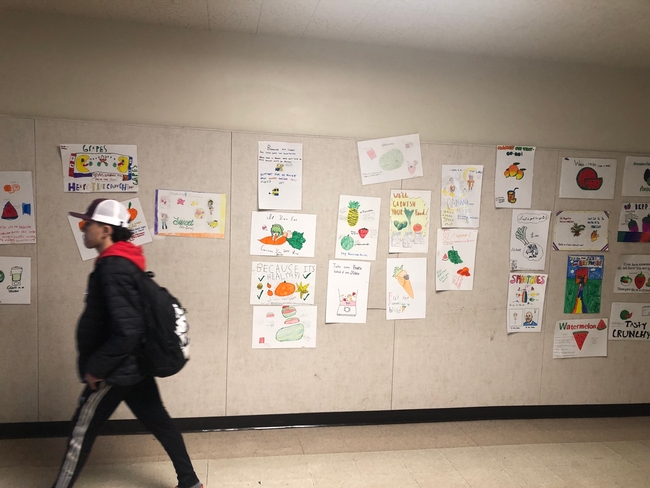
The Issue
Food and beverage companies invest over $1 billion in marketing each year to advertise their food products to Black and Hispanic consumers, specifically the youth. Students at Hillview Jr. High School (HJHS)–which is located in a low-income neighborhood of Pittsburg and has a 60% Hispanic and 19% African American student population– are not exempt from these widespread and targeted food marketing campaigns. Fast food restaurants, convenience stores, and gas stations line the main street avenue near the school, attracting hungry teens.The easy availability and promotion of these foods, which are linked to negative life-long consequences, influence the food choices made by youth every day. When hunger strikes, healthy eating and active living are out of sight and out of mind to many teens.
How UC Delivers
CFHL, UCCE in Contra Costa County partnered with HJHS to deliver EatFit during the 2022-2023 school year. EatFit is a nutrition education goal-setting curriculum designed to challenge middle school students to improve their eating and fitness choices. The program reached 149 students who participated in activities focused on goal setting, nutrition facts label, energy, breakfast, exercise, fast food, and the media's influence on food choices.
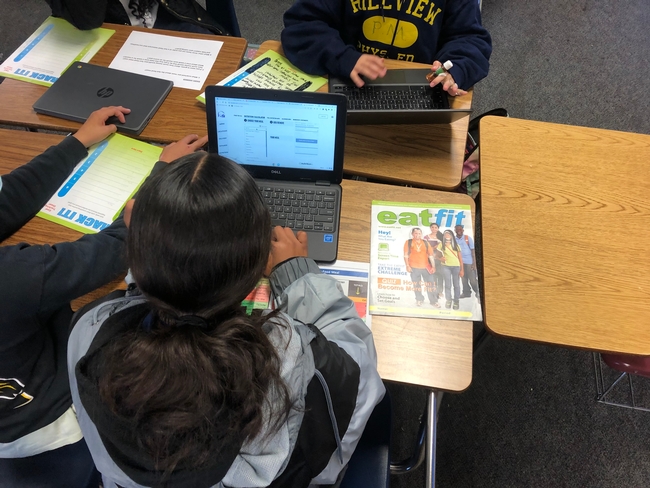
In one of the EatFit lessons, students learned about food marketing. They were asked to name a commercial or ad on the Internet about water or healthy food. None could. However, when asked for examples of fast food or soda ads and commercials, all hands went up. Some students even sang the jingle or acted out the commercial. Students realized that food companies target young people and hardly promote healthy foods. Instead, TV commercials and advertisements on the Internet and social media try to persuade teens to eat and drink unhealthy foods and sugary beverages that harm their health. In the same lesson, students also learned about food marketing techniques and were encouraged to create fruit and vegetable posters to promote healthy choices at school.
With support from the principal, the school's busiest hallways were decorated with students' colorful fruit and vegetable posters. Not one poster was vandalized or torn off.
The Impact
One hundred and seventeen students in grades 6-8 completed the Eating and Activity Tool for Students (EATS) pre-post survey at Hillview Jr. High to assess changes in their behaviors after participating in the FY 2023 EatFit lesson series. Respondents were ten to thirteen years old, and identified as Latino or Hispanic (48%), Black or African American (18%), or more than one race (27%). After taking part in EatFit, the student survey results included the following:
- 34% increased the number of time they ate fruit yesterday.
- 30% increased the number of time they ate vegetables yesterday.
- 50% reduced the number of times they drank sweetened beverages yesterday - with the largest decreases seen in fruit drinks, soda, and sweetened coffees and teas.
- 40% increased the number of days they were physically active for 60 minutes or more last week.
“One change I made to eat healthier/be more physically active is to exercise/stretch when I wake up and lower how much unhealthy food I eat (high fat food, high calories etc) and start eating more fruits and veggies.” — EatFit Participant
This work is vital in adolescents as they begin to become more independent in the way they think, learn, and interact with food. Likewise, nutrition education intervention efforts in majority Black, Indigenous, and People of Color (BIPOC) communities are of particular importance because these groups have been expressly targeted as potential consumers of nutrient-poor food while also facing barriers to accessing affordable and convenient healthy food. By supporting students to reflect critically on how unhealthy food and beverages are advertised to them and then develop their counter-messages to promote healthy choices, inclusive SNAP-Ed-approved programs like EatFit and others can help improve nutrition behaviors among low-income adolescent Californians and prevent the chances of developing chronic disease later in life.
CFHL, UCCE staff will continue to partner with Hillview Jr. High to deliver quality nutrition education during the 2023-2024 school year. The fruit and vegetable posters made by students serve as a friendly reminder to all that food marketing does not steal your independence; you can still make a healthy, tasty choice.
“Before, I use to just get snacks to eat them but a lot of them were unhealthy and I got cavities. During the lesson we learned that the labels are actually important. Now I check the label to compare and buy the snack that is more healthy. It is working I am more healthy and happy.”— Jacob Ponce, EatFit Participant
- Author: Amanda M Linares
- Contributor: Kaela Plank
- Contributor: Sridharshi Hewawitharana
- Contributor: Gail Woodward-Lopez
- View More...
Nutrition Policy Institute rolled out an online evaluation tool, EATS, for local health departments to evaluate school-based CalFresh Healthy Living during pandemic-related school closures. EATS data showed that students receiving school meals during the closures were more likely to eat fruits and vegetables, an important insight that could impact school nutrition policy in the future.
The Issue
In March 2020, schools across California shuttered in an effort to protect students and staff from COVID-19 infection. School closures impacted provision of the National School Lunch Program and School Breakfast Program, and thus, the nutrition safety net they provided. School districts across the state pivoted to centralized meal distribution via grab-and-go and drive-up, or even utilized home delivery in some cases. Despite monumental efforts to get school meals to the children who needed them most, meal participation declined significantly during this time.
The California Department of Public Health's CalFresh Healthy Living Program (CDPH-CFHL) prioritizes improving child nutrition security and diet quality. Local health departments partner with K-12 schools to implement CFHL nutrition education and policy, systems, and environmental (PSE) change strategies that aim to increase consumption of fruits and vegetables and decrease consumption of sugary drinks. Their existing relationships with school districts enabled them to support efforts to ensure that school meals met dietary standards and student needs during school closures.
How UC Delivers
During the pandemic, local health departments modified their school-based programs to continue to reach students outside of the school setting. For example, they delivered nutrition education remotely via Zoom or pre-recorded lessons, and they pivoted to PSE change strategies like modifying school meal distribution practices to help ensure students continued to have access to healthy foods.
Nutrition Policy Institute supports local health department evaluation of school-based CDPH-CFHL interventions, and without modifying the existing data collection methodology to reach students learning at home, evaluation would not have continued. Evaluators adapted their methods, including migration of the Eating and Activity Tool for Students (EATS) to an online platform. This survey measures student eating and physical activity behaviors, and during pandemic school closures, included questions about if and where students ate school breakfast and lunch. Nutrition Policy Institute prioritized school data collection during this extraordinary period, understanding that analysis of these data could draw attention to the impacts of COVID-19 on California's youth, in particular, those already facing nutrition disparities.
The Impact
During the 2020-21 school year, as a result of Nutrition Policy Institute's development and coordination of the online EATS tool, local health departments were able to collect data from 3,297 4th and 5th grade students from 67 CFHL-eligible schools (where at least half of students are eligible for free or reduced-price meals). About half of students were female (52%) and half identified as Latino (50%). Most students were attending school exclusively by distance learning at the time of the survey (83%). Approximately one quarter of students had eaten at least one school meal the previous day (27%), with about 1 in 7 reporting they ate both breakfast and lunch (15%).
We found that students who ate one or two school meals a day had significantly higher intakes of vegetables, whole fruits, and 100% fruit juice, compared to students who did not eat school meals. Specifically, students who ate one school meal a day ate more beans and orange vegetables, while those who ate two school meals a day consumed a wider variety of vegetables, including beans and orange vegetables. However, children who ate one school meal a day drank more fruit drinks (non-100% juice) and flavored milks than those who did not eat school meals. Further, students who ate two school meals consumed more fruit drinks, flavored milks, and sports and energy drinks than those who did not eat school meals.
Our findings suggest that school meals continued to be an important source of fruits and vegetables for school-aged children during the pandemic. This highlights the importance of focusing PSE efforts on improving school meal distribution and overall quality, should students' in-person attendance be challenged again. Despite this, findings also underscore the need to reduce consumption of sugary drinks, which are a primary source of added sugars and nutrient poor energy in children's diets. This highlights an opportunity to strengthen school-based CFHL interventions by incorporating nutrition education and PSE strategies that focus specifically on healthy beverage consumption. Nutrition Policy Institute's leadership of CDPH-CFHL local program evaluation not only highlights the successes of CFHL, but just as important, the areas for program improvement. Nutrition Policy Institute's commitment to strengthening CDPH-CFHL interventions in California schools is a hallmark of UC ANR's public value of promoting healthy people and healthy communities.
This study was conducted as part of a contract with the California Department of Public Health with funding from the United States Department of Agriculture (USDA) Supplemental Nutrition Assistance Program-- SNAP. These institutions are equal opportunity providers and employers.
- Author: Alireza Pourreza
UC Digital Agriculture Program's innovative spray backstop system reduces airborne pesticide drift by 78% in almond orchards– a big step forward for improving air quality and working conditions in California's agricultural production areas.
The Issue
Pesticide drift is a significant concern, especially in California's almond orchards. It's not just an environmental issue. Pesticide drift can pose a public health risk by contaminating the skin, lungs, and gut of people in nearby communities. These chemicals can lead to respiratory issues, skin irritation, and other adverse health effects. Another study highlights that pesticide poisoning is a significant cause of morbidity and mortality, affecting not just agricultural workers but also the general population.The challenge has been to control this drift without reducing the effectiveness of the pesticide application. This project aims to tackle this pressing issue head-on.
How UC Delivers
Addressing the issue of pesticide drift requires a multi-disciplinary approach, combining engineering, agriculture, and environmental science expertise. The UC Digital Agriculture Program team rose to the challenge by developing an innovative spray backstop system. This system is a blend of practicality and advanced technology, designed to be both farmer-friendly and effective in reducing pesticide drift.
The core components of this system are a foldable mast and a shade structure. The mast is the backbone, providing the necessary height and stability, while the shade structure acts as a barrier covering the trees from the top. This barrier is crucial in preventing the upward movement of pesticide droplets, thereby reducing the potential for drift.
Figure 1: Schematic design of the backstop prototype installed on a sprayer in an almond orchard.
To validate the effectiveness of this system, a series of tests were conducted in young almond orchards. The sprayer was operated at a 3.2 km/h speed to simulate real-world conditions. But before hitting the field, the team employed advanced uncrewed aerial systems equipped with thermal and RGB cameras. These cameras captured images and videos of the spray pattern from multiple angles, providing invaluable data for analysis.
The aerial imagery was not just for show; it played a pivotal role in the project. It allowed the team to monitor the spray application in real-time and understand the spray cloud's movement pattern. This imagery was then used to refine the design of the shade structure, ensuring it effectively blocked droplet movement beyond the treetop.
Figure 2: Aerial views showing the efficiency of the backstop prototype in blocking the spray cloud.
The results were more than just promising. The backstop system effectively blocked the spray cloud, ensuring that the pesticides stayed precisely where they were intended to be—on the trees. This was further validated through a ribbon test, a simple yet effective method to measure drift. A ribbon placed in the spray path remained in its resting position when the backstop system was used, indicating a significant reduction in drift.
The project didn't stop at just reducing drift; it also ensured that the reduction did not come at the cost of effectiveness. The on-target deposition of the pesticide was not compromised, affirming that the system could achieve dual objectives: reducing drift while maintaining efficacy.
The Impact
The spray backstop system's impact goes beyond just numbers. It represents a significant stride toward sustainable agriculture and community well-being. The system successfully reduced the drift potential by 78%. This isn't merely a statistic; it's a tangible change that has far-reaching implications for both environmental stewardship and human safety.
Figure 3: Statistical results showcasing a significant reduction in drift potential.
The environmental impact is equally noteworthy. Reduced drift means fewer chemicals in the air, contributing to "improved air quality," a UC ANR condition change. This is a step forward in reducing air pollution, which has wide-ranging implications for human health and climate change.
One of the most noteworthy aspects of this innovation is that it managed to reduce drift without compromising the effectiveness of the pesticide application. The on-target deposition remained consistent, ensuring the almond trees received the necessary pesticide coverage for optimal growth and yield. This is a crucial factor for farmers who are often caught in the dilemma of choosing between effective pest control and environmental responsibility.
Figure 4: Comparative leaf samples illustrating consistent on-target deposition and coverage.
The project aligns with another UC ANR's condition change, "improved living and working conditions for California's food system and farm workers." One of the goals of reducing pesticide drift is to mitigate the health risks associated with working and living in agricultural production areas. Therefore, the work directly supports UC ANR's commitment to promoting the public health of California's communities.
Looking ahead, the project has set the stage for further research and development to adapt the system for different types of orchards and terrains. Additional modifications are being considered to make the system even more robust and versatile, ensuring its long-term sustainability and broader applicability.
Want to learn more? See the method in action here.






